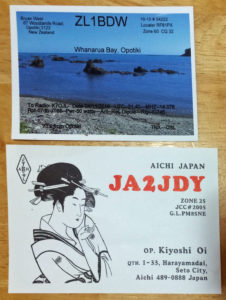
JT65 is a weak signal system. QSO’s are possible but take quite a bit of time to complete and even then, only a little bit of information can be transmitted. If the software is set up to send reports to pskreporter and to the Reverse Beacon Network (highly recommended to enable both options), every station that my software decodes will be reported along with the signal strength of the received signal. This is very helpful to others who are transmitting in the jT65 mode and want to know where their signal is being received and the relative signal strength of the received signal.
I let JT65 run for several hours while I was doing other things in the “shack”. I had a few minutes, so I responded to several CQ’s and managed to have two JT65 conversations. The first was with a ham in New Zealand and a while later I was able to make contact with a ham from Japan. I fired off a QSL card to each of them and included two one-dollar bills in the hopes they would send back a QSL card. Both did! The cards are in the picture above.
The weather here in Hawaii is not kind to things hanging out in the breeze. Consequently, leaving the Buddipole up for any period of time is asking for problems. In that period of time, one of the clamps on the tripod grew some serious crud that needed to be cleaned off and re-oiled. Now I’m hoping for another few days when the antenna can go up and I can try some more JT65. For more information on this app, please see JT65-HF.COM as well as the Wikipedia page on the mode / protocol.